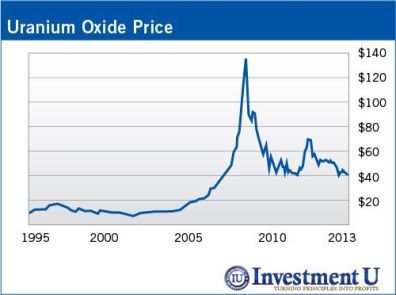 Something big is about to strike the mining industry. When it does, savvy investors have a grand opportunity on their hands.
Something big is about to strike the mining industry. When it does, savvy investors have a grand opportunity on their hands.
It all started back in 1993 when the United States and Russia signed a historic agreement creating what’s called the “Megatons to Megawatts” (MTM) program.
The program’s goal is turn the deadly highly enriched uranium inside Russian nuclear weapons into the fuel for American power plants.
[ad#Google Adsense 336×280-IA]When the program comes to an end in December, it will have converted 500 metric tons of highly enriched uranium (about 20,000 nuclear warheads’ worth) into fuel for America’s nuclear reactors.
On March 4, 2012, Russians re-elected Vladimir Putin for a third term.
Given Putin’s disdain for the West, it’s doubtful the MTM program will continue.
It will leave a big hole in the world’s supply of enriched uranium.
It will also leave Russia in the uranium catbird seat. As the supply from dismantled warheads wanes, worldwide uranium prices could double from current levels.
Ready to Spike
Take a look at the graph below…
 The spot price for uranium soared to nearly $140 per pound in 2007. Then, almost as quickly as it soared, the price plummeted to the $40 level in early 2009.
The spot price for uranium soared to nearly $140 per pound in 2007. Then, almost as quickly as it soared, the price plummeted to the $40 level in early 2009.
The green metal managed to claw back to $70 per pound in early 2011. But then a nuclear disaster shook the sector… Fukushima. Following an earthquake and a disastrous tsunami, the Japanese plant experienced a deadly meltdown.
Next to Russia’s Chernobyl accident in 1986, Fukushima is the only incident to reach Level 7 on the International Nuclear Event scale.
Countries around the world reacted hastily.
- Japan shut down all 50 of its nuclear reactors.
- Germany shut down 8 of its 17 reactors and resolved to phase out the rest by 2022.
- Switzerland decided on a slow phaseout starting in 2019 and extending through 2034.
And prior the Fukushima disaster Austria, Sweden, Italy and Belgium had plans to eliminate their nuclear facilities.
The sudden plunge in demand once again sent uranium prices to the $40 level. But prices won’t stay this low for much longer.
No Other Choice
Japan’s initial reactor shutdowns and those planned by European countries will have little, if any, effect on long-term uranium demand.
Right now, there are 435 nuclear power plants in operation around the globe. An additional 67 more are under construction. Incredibly, despite the Fukushima fallout, another 317 are proposed and could be on line in as few as 15 years.
A World Nuclear Association report from August 2011 (five months after Japan’s meltdown) had this to say about the growth of nuclear power:
“[There are] 60 reactors being built around the world today. Another 150 or more are likely to come online during the next 10 years. Over 200 are further back in the pipeline.
“The global nuclear industry is clearly going forward strongly. Countries with established programs are seeking to replace old reactors as well as expand capacity.
“An additional 25 countries are either considering or have already decided to make nuclear energy part of their power generation capacity. Most (over 80%) of the expansion in this century is likely to be in countries already using nuclear power.”
For uranium bulls, it’s great news. Demand is about to outstrip supply.
In 2011, the world’s reactors used 165 million pounds of uranium. At the same time, global production amounted to just 143 million pounds.
The MTM program was there to fill the balance.
But that’s about to change…
When the deal with the Russians ends, 24 million pounds of uranium supply will instantly disappear. And it will happen just as global demand begins to surge.
Annual production will need to increase as much as 136,000 tons by 2035 in order to keep up with demand. Not only will we need more mines, we’ll also need more processing facilities to turn raw uranium into a product suitable for nuclear fuel.
Bottom line… somebody’s going to get rich.
One of Many
While Kazakhstan has emerged as the world’s largest supplier of uranium, Canada is No. 2. The biggest supplier in Canada is Cameco Corporation (NYSE: CCJ). It’s one of many companies that will ride the back of the uranium bull.
Cameco mines are responsible for about 14% of global uranium production. It owns mines in Canada, the United States and Kazakhstan – which collectively hold 465 million pounds of proven and probable reserves.
The company’s flagship operation is the McArthur River Key Lake mine. Located in Saskatchewan’s Athabasca Basin, the mine is the largest high-grade uranium mine in the world.
Its average ore grade is 100 times greater than the world average.
Cameco also owns the world’s second largest deposit of high-grade uranium. Its Cigar Lake mine, also in the Athabasca Basin, is still under development. Production is on schedule to start by the end of June. Once the mine is running, it will produce 18 million pounds of uranium per year.
The company expects its total annual production to be 36 million pounds by 2018.
Cameco’s share price has seesawed between $16.41 and $23.23 over the past year. The stock is currently trading about $2 off its highs.
The mainstream media and the investing herd will soon get wind of the coming uranium shortage.
Shares of Cameco, along with those of other uranium miners, could explode higher on the news.
As the program that kept the uranium bull in the pasture comes to an end, something big is about to stir the mining industry.
Good investing,
Dave
[ad#leeb-article]
Source: Investment U


